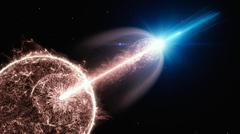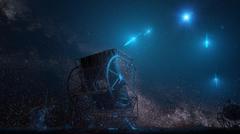URL: https://www.desy.de/news/news_search/index_eng.html
Breadcrumb Navigation
DESY News: Front-row view reveals exceptional cosmic explosion
News
News from the DESY research centre
Front-row view reveals exceptional cosmic explosion
Scientists have gained the best view yet of the brightest explosions in the universe: A specialised observatory in Namibia has recorded the most energetic radiation and longest gamma-ray afterglow of a so-called gamma-ray burst (GRB) to date. The observations with the High Energy Stereoscopic System (H.E.S.S.) challenge the established idea of how gamma-rays are produced in these colossal stellar explosions which are the birth cries of black holes, as the international team reports in the journal Science.

Artist's impression of a relativistic jet of a gamma-ray burst (GRB), breaking out of a collapsing star, and emitting very-high-energy photons. Credit: DESY, Science Communication Lab
On 29 August 2019 the satellites Fermi and Swift detected a gamma-ray burst in the constellation of Eridanus. The event, catalogued as GRB 190829A according to its date of occurrence, turned out to be one of the nearest gamma-ray bursts observed so far, with a distance of about one billion lightyears. For comparison: The typical gamma-ray burst is about 20 billion lightyears away. “We were really sitting in the front row when this gamma-ray burst happened,” explains co-author Andrew Taylor from DESY. The team caught the explosion's afterglow immediately when it became visible to the H.E.S.S. telescopes. “We could observe the afterglow for several days and to unprecedented gamma-ray energies,” reports Taylor.

X-rays from the GRB were detected by NASA's Swift satellite in Earth's orbit. Very-high-energy gamma rays entered the atmosphere and initiated air showers that were detected by H.E.S.S. from the ground (artist’s impression). Credit: DESY, Science Communication Lab
The team could follow the afterglow up to three days after the initial explosion. The result came as a surprise: “Our observations revealed curious similarities between the X-ray and very-high energy gamma-ray emission of the burst's afterglow,” reports Zhu. Established theories assume that the two emission components must be produced by separate mechanisms: the X-ray component originates from ultra-fast electrons that are deflected in the strong magnetic fields of the burst's surroundings. This “synchrotron” process is quite similar to how particle accelerators on Earth produce bright X-rays for scientific investigations.
However, according to existing theories it seemed very unlikely that even the most powerful explosions in the universe could accelerate electrons enough to directly produce the observed very-high-energy gamma rays via this synchrotron process. This is due to a “burn-off limit”, which is determined by the balance of acceleration and cooling of particles within an accelerator. Producing very-high-energy gamma rays through synchrotron radiation requires electrons with energies well beyond the burn-off limit. Instead, current theories assume that in a gamma-ray burst, fast electrons collide with synchrotron photons and thereby boost them to gamma-ray energies in a process dubbed synchrotron self-Compton.

Artist's impression of very-high-energy photons from a GRB entering Earths’ atmosphere and initiating air showers that are being recorded by the H.E.S.S. telescopes. Credit: DESY, Science Communication Lab
The far-reaching implication of this possibility highlights the need for further studies of very-high energy GRB afterglow emission. GRB 190829A is only the fourth gamma-ray burst detected at very high energies from the ground. However, the earlier detected explosions occurred much farther away in the cosmos and their afterglow could only be observed for a few hours each and not to energies above 1 tera-electronvolts (TeV). “Looking to the future, the prospects for the detection of gamma-ray bursts by next-generation instruments like the Cherenkov Telescope Array that is currently being built in the Chilean Andes and on the Canary Island of La Palma look promising,” says H.E.S.S. spokesperson Stefan Wagner from Landessternwarte Heidelberg. “The general abundance of gamma-ray bursts leads us to expect that regular detections in the very-high energy band will become rather common, helping us to fully understand their physics.”
More than 230 scientists from 41 institutes in 15 countries (Namibia, South Africa, Germany, France, the UK, Ireland, Italy, Austria, the Netherlands, Poland, Sweden, Armenia, Japan, China and Australia), comprising the international H.E.S.S. collaboration, contributed to this research. H.E.S.S. is a system of five Imaging Atmospheric Cherenkov Telescopes that investigates cosmic gamma rays. The name H.E.S.S. stands for High Energy Stereoscopic System, and is also intended to pay homage to Victor Franz Hess, who received the Nobel Prize in Physics in 1936 for his discovery of cosmic radiation. H.E.S.S. is located in Namibia, near the Gamsberg mountain, an area well known for its excellent optical quality. Four H.E.S.S. telescopes went into operation in 2002/2003, the much larger fifth telescope - H.E.S.S. II - is operational since July 2012, extending the energy coverage towards lower energies and further improving sensitivity. In 2015-2016, the cameras of the first four H.E.S.S. telescopes were fully refurbished using state of the art electronics and in particular the NECTAr readout chip designed for the next big experiment in the field, the Cherenkov Telescope Array (CTA), for which the data science management centre will be hosted by DESY on its Zeuthen site.
Reference:
Revealing x-ray and gamma ray temporal and spectral similarities in the GRB 190829A afterglow; H.E.S.S. collaboration; Science, 2021; DOI: 10.1126/science.abe8560
Roughly 900 million years later, radiation from this gamma-ray burst arrives at Earth and is detected by satellites and telescopes as GRB 190829A. High-energy photons hitting Earth's atmosphere produce particle showers that emit so-called Cherenkov light for a couple of nanoseconds. This glow can be detected by telescopes such as H.E.S.S. This way, H.E.S.S. could follow GRB 190829A for three nights in a row in unprecedented detail.
Credit: DESY, Science Communication Lab
(Swift model from NASA model database)
High-definition version available to the media; please contact presse@desy.de



